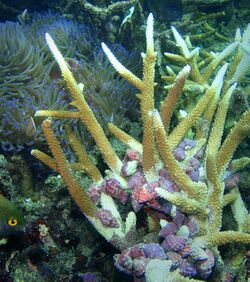Biology:Drupella rugosa
| Drupella rugosa | |
|---|---|

| |
| Feeding aggregation of Drupella Rugosa snails on Acropora branching corals on the island of Koh Tao, Thailand. | |
| Scientific classification | |
| Kingdom: | |
| Phylum: | |
| Class: | |
| (unranked): | |
| Superfamily: | |
| Family: | |
| Subfamily: | |
| Genus: | |
| Species: | D. rugosa
|
| Binomial name | |
| Drupella rugosa (Born, 1778)
| |
| Synonyms[1] | |
| |
Drupella rugosa, common name : the rugose drupe, is a species of sea snail, a marine gastropod mollusk in the family Muricidae, the murex snails or rock snails.[1]
Description
Drupella rugosa is a creamy white to orange, conical shell with a height between 20 mm and 35 mm. The sculpture shows five spiral rows of rounded brown nodules separated by twelve axial ribs with fine granules, giving the shell a knobby appearance. The columella is narrow and the anal sinus hardly shows. The elliptical aperture is narrowed by protruding plaits. The outer lip is with five or six teeth.
Feeding patterns
Drupella rugosa is an obligate corallivore that grazes on the tissue of live corals, especially fast growing or structurally diverse corals such as Acropora and Montipora. Over-populations or outbreaks of the snail have been recorded in multiple regions since the 1980s,[2] and generally occur on reefs impacted by human activities or following mass mortality events such as coral bleaching.[3] D. Rugosa is known to contribute to secondary mortality following such events,[4] and have also been linked to increased prevalence of coral diseases.[5]
Distribution and Reproduction
This species is distributed in the intertidal zone and shallow rocky areas in the Red Sea and in the Indian Ocean along Aldabra, Chagos, Madagascar , the Mascarene Basin, the Gulf of Thailand,[3] and in the Western Pacific. Little is known about their reproductive cycle, however it was recently documented in the Gulf of Thailand that they use the skeletons of the corals they have recently consumed on which to lay their benthic eggs, particularly on corals of the Fungiidae Family.[6]
References
- ↑ 1.0 1.1 Drupella rugosa (Born, 1778). Retrieved through: World Register of Marine Species on 24 April 2010.
- ↑ Moyer, Jack T.; William K. Emerson; Michael Ross. "Massive destruction of scleractinian corals by the muricid gastropod, Drupella, in Japan and the Philippines.". Nautilus 96 (2): 69–82.
- ↑ 3.0 3.1 Hoeksema, Bert W.; Chad M. Scott; James D. True (2013). "Dietary shift in corallivorous Drupella snails following a major bleaching event at Koh Tao, Gulf of Thailand". Coral Reefs 32 (2): 423–428. doi:10.1007/s00338-012-1005-x.
- ↑ Antonius, A.; B. Riegl (1998). "Coral disease and Drupella cornus invasions in the Red Sea.". Coral Reefs 17 (1): 48. doi:10.1007/s003380050093.
- ↑ Lamb, Joleah; James D. True; Srisakul Piromvaragorn; Bette L. Willis (2014). "Scuba diving damage and intensity of tourist activities increases coral disease prevalence". Biological Conservation 178: 88–96. doi:10.1016/j.biocon.2014.06.027. https://www.researchgate.net/publication/264557713.
- ↑ Scott, Chad; Mehrotra, Rahul; Hoeksema, Bert W. (1 August 2017). "In-situ egg deposition by corallivorous snails on mushroom corals at Koh Tao (Gulf of Thailand)". Journal of Molluscan Studies 83 (3): 360–362. doi:10.1093/mollus/eyx020.
- Dautzenberg, Ph. (1929). Mollusques testaces marins de Madagascar. Faune des Colonies Francaises, Tome III
- Drivas, J. & M. Jay (1988). Coquillages de La Réunion et de l'île Maurice
External links
- "Drupella rugosa" (in en). Gastropods.com. http://www.gastropods.com/2/Shell_4232.shtml.
Wikidata ☰ Q5309381 entry
 |

